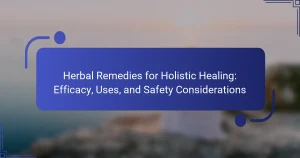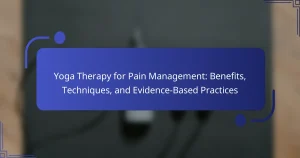Massage therapy is a proven method for relaxation, offering techniques such as Swedish massage, deep tissue massage, and aromatherapy. These methods effectively reduce stress, enhance mood, and improve sleep quality. Client feedback emphasizes immediate relaxation and long-term benefits, highlighting the importance of skilled therapists and a calming environment. Consistent sessions can significantly enhance overall well-being and alleviate muscle tension.
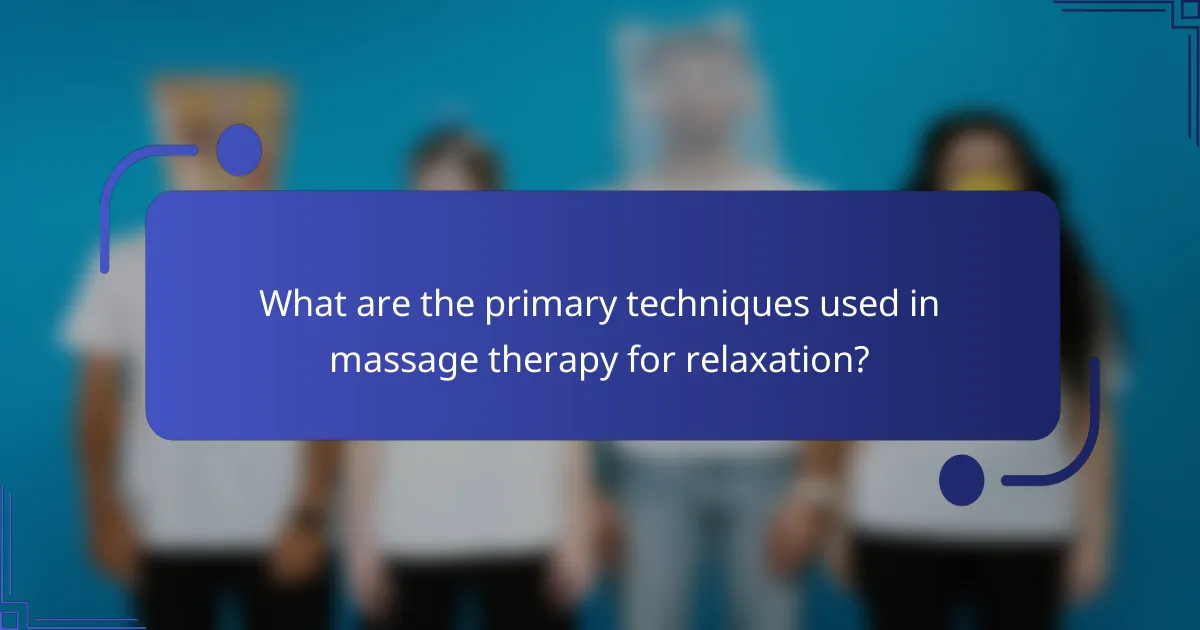
What are the primary techniques used in massage therapy for relaxation?
Massage therapy for relaxation primarily uses techniques such as Swedish massage, deep tissue massage, and aromatherapy. These methods promote relaxation, reduce stress, and enhance overall well-being.
Swedish massage employs long, gliding strokes and kneading to improve circulation and relieve tension. Deep tissue massage targets deeper muscle layers, alleviating chronic pain and muscle stiffness. Aromatherapy combines essential oils with massage to enhance relaxation through scent, creating a calming atmosphere.
Client feedback often highlights the immediate sense of relaxation and reduced anxiety following these techniques. Regular sessions can lead to long-term benefits, including improved sleep quality and enhanced mood.
How does Swedish massage promote relaxation?
Swedish massage promotes relaxation by using long, flowing strokes that enhance blood circulation and reduce muscle tension. This technique encourages the release of endorphins, which improve mood and alleviate stress. The rhythmic movements and gentle pressure help calm the nervous system, leading to a deep state of relaxation. Clients often report improved sleep quality and a sense of overall well-being after sessions.
Which benefits does deep tissue massage offer for stress relief?
Deep tissue massage effectively reduces stress by alleviating muscle tension and promoting relaxation. It targets deeper layers of muscle and connective tissue, leading to improved circulation and reduced cortisol levels. Research indicates that this technique can enhance overall well-being and improve sleep quality, making it a valuable tool for stress relief. Additionally, client feedback often highlights the immediate sense of relaxation and long-term benefits in managing stress-related symptoms.
What role does aromatherapy play in enhancing massage therapy experiences?
Aromatherapy significantly enhances massage therapy experiences by promoting relaxation and improving emotional well-being. Essential oils, such as lavender and eucalyptus, are commonly used to create a calming atmosphere. These oils can reduce stress and anxiety, leading to a more effective massage. Client feedback often highlights increased satisfaction when aromatherapy is incorporated. Additionally, the olfactory stimulation from the scents can deepen the overall relaxation response, making the massage more enjoyable and beneficial.
How can hot stone massage contribute to relaxation?
Hot stone massage significantly contributes to relaxation by soothing tense muscles and promoting a calming effect. The heated stones, typically basalt, provide deep tissue warmth, which enhances blood flow and alleviates stress. As a result, clients often report improved mood and reduced anxiety levels. Additionally, the unique attribute of this technique is its ability to combine traditional massage with the therapeutic benefits of heat, creating a holistic experience that fosters deep relaxation.
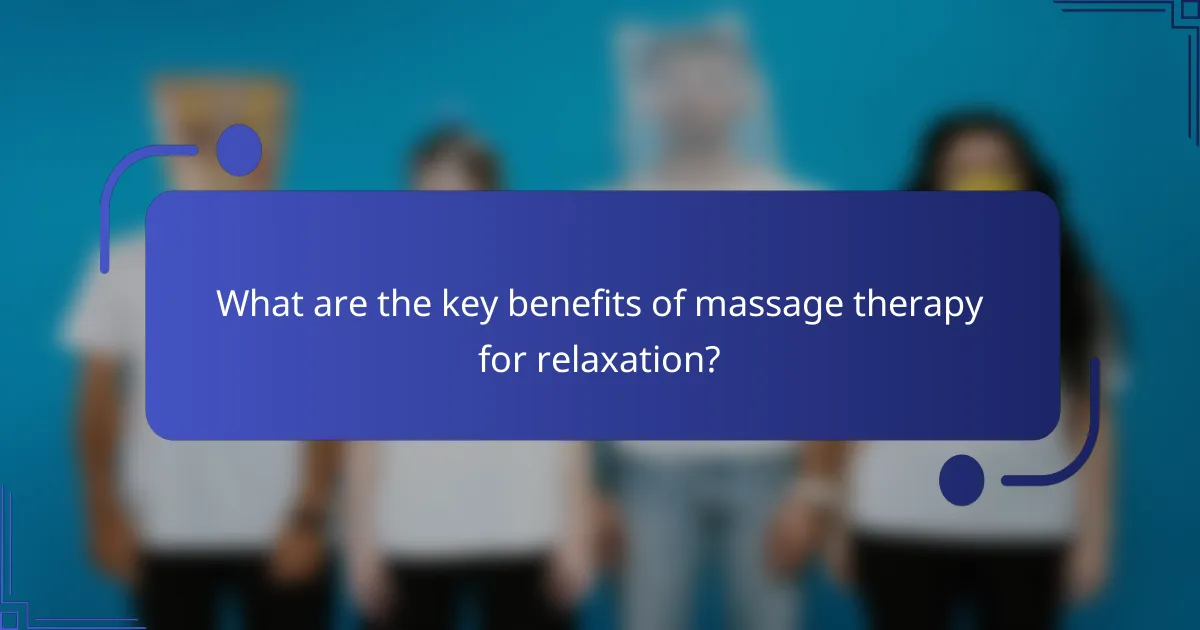
What are the key benefits of massage therapy for relaxation?
Massage therapy offers numerous benefits for relaxation, including reduced stress, improved mood, and enhanced sleep quality. It promotes muscle tension relief and increases blood circulation, which can further contribute to overall well-being. Research indicates that regular massage can lower cortisol levels, leading to a more relaxed state. Additionally, client feedback often highlights the calming effects of massage, making it a popular choice for stress relief.
How does massage therapy reduce stress and anxiety levels?
Massage therapy effectively reduces stress and anxiety levels by promoting relaxation and enhancing overall well-being. Techniques such as Swedish massage, deep tissue massage, and aromatherapy target muscle tension and stimulate the release of endorphins. Research indicates that regular massage therapy can lower cortisol levels, which are linked to stress. Client feedback often highlights improved mood and reduced anxiety after sessions, reinforcing the therapy’s benefits.
What impact does massage therapy have on sleep quality?
Massage therapy significantly improves sleep quality by promoting relaxation and reducing stress. Techniques like Swedish massage and deep tissue massage enhance blood circulation and alleviate muscle tension, leading to better sleep patterns. Client feedback often highlights increased feelings of calm and improved overall well-being after sessions. Studies indicate that regular massage therapy can decrease insomnia symptoms, making it a valuable tool for those seeking restful sleep.
Which physical benefits can be gained from regular massage sessions?
Regular massage sessions provide numerous physical benefits, including reduced muscle tension, improved circulation, and enhanced flexibility. These effects contribute to overall physical well-being and recovery.
Massage therapy can alleviate pain, such as chronic back pain or headaches, by targeting specific muscle groups. Additionally, it promotes relaxation, which can lower stress levels and improve mental clarity. Regular sessions can also enhance athletic performance by preparing muscles for exertion and aiding in recovery post-exercise.
Studies indicate that massage can reduce cortisol levels, leading to decreased stress and improved immune function. This combination of physical and psychological benefits makes massage therapy a valuable addition to wellness routines.
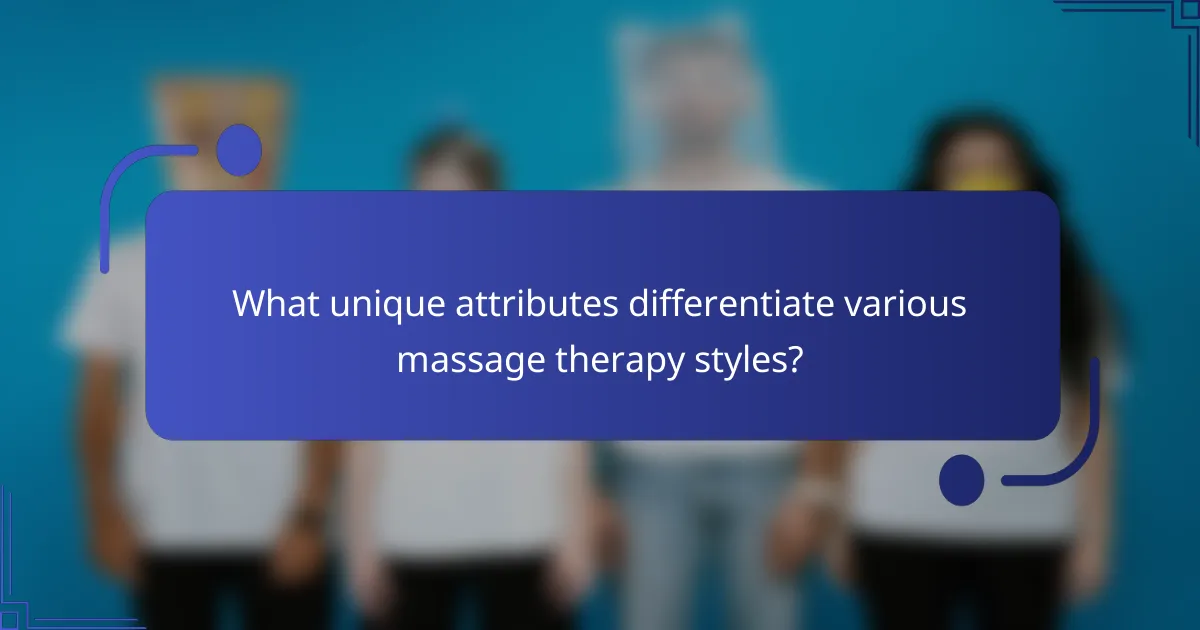
What unique attributes differentiate various massage therapy styles?
Various massage therapy styles are differentiated by unique attributes such as technique, pressure, and focus areas. For example, Swedish massage emphasizes long, flowing strokes for relaxation, while deep tissue massage targets muscle knots using deeper pressure. Thai massage incorporates stretching and acupressure, offering a unique blend of techniques. Hot stone massage utilizes heated stones to enhance relaxation and alleviate muscle tension. Each style caters to different client needs, reflecting individual preferences and therapeutic goals.
How do cultural variations influence massage techniques and practices?
Cultural variations significantly influence massage techniques and practices, shaping methods, goals, and client interactions. Different cultures emphasize unique attributes, such as pressure intensity, rhythm, and use of oils. For instance, Swedish massage focuses on relaxation and circulation, while Thai massage incorporates stretching and energy flow. Cultural beliefs also affect the perceived benefits of massage, with some societies valuing spiritual healing alongside physical relief. Client feedback often reflects these cultural nuances, highlighting preferences for specific techniques or approaches that resonate with their backgrounds.
What are the distinct philosophies behind Eastern versus Western massage approaches?
Eastern massage philosophies emphasize energy flow and holistic healing, while Western approaches focus on anatomy and muscle tension relief. Eastern techniques, like acupuncture and Shiatsu, aim to balance the body’s energy through meridians. In contrast, Western methods, such as Swedish and deep tissue massage, prioritize physical manipulation to alleviate pain and promote relaxation. Each philosophy offers unique benefits, catering to different client preferences and needs. Understanding these distinctions helps clients choose the most suitable massage therapy for relaxation.
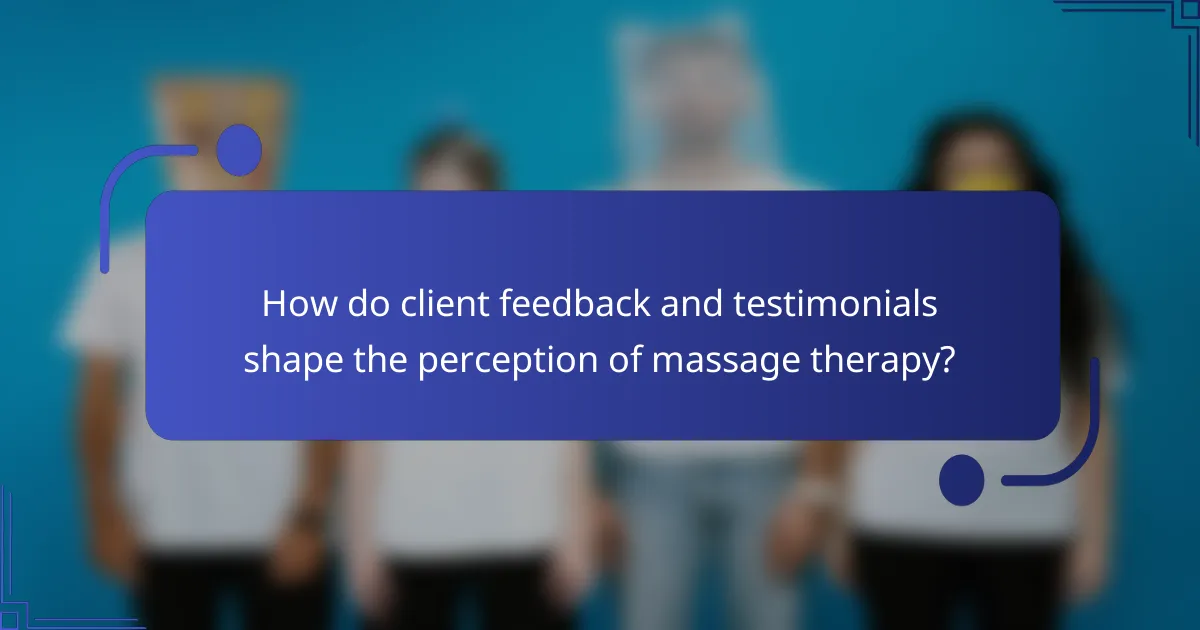
How do client feedback and testimonials shape the perception of massage therapy?
Client feedback and testimonials significantly enhance the perception of massage therapy by building trust and credibility. Positive reviews often highlight relaxation benefits, leading potential clients to choose these services. Clients frequently mention reduced stress and improved well-being as key outcomes. Additionally, testimonials can showcase unique techniques, such as deep tissue or aromatherapy, which differentiate practitioners. As a result, effective client feedback creates a compelling narrative that influences new clients’ decisions.
What common themes emerge from client reviews of relaxation-focused massage therapy?
Common themes from client reviews of relaxation-focused massage therapy include enhanced stress relief, improved sleep quality, and increased overall well-being. Clients frequently highlight the soothing atmosphere and skilled techniques used by therapists. Many report feeling a significant reduction in muscle tension and anxiety after sessions. Personalized approaches, such as tailored pressure and specific techniques, often receive positive feedback, enhancing the overall relaxation experience.
How does client feedback inform therapists about improving their techniques?
Client feedback is essential for therapists to enhance their techniques. It provides insights into client preferences, areas for improvement, and overall satisfaction with the massage therapy experience. Therapists can adjust their methods based on specific feedback regarding pressure, technique, and areas of focus. This iterative process fosters a more personalized approach, ultimately leading to better client outcomes and stronger therapeutic relationships. Regularly incorporating client feedback ensures that therapists remain attuned to individual needs and can refine their skills effectively.
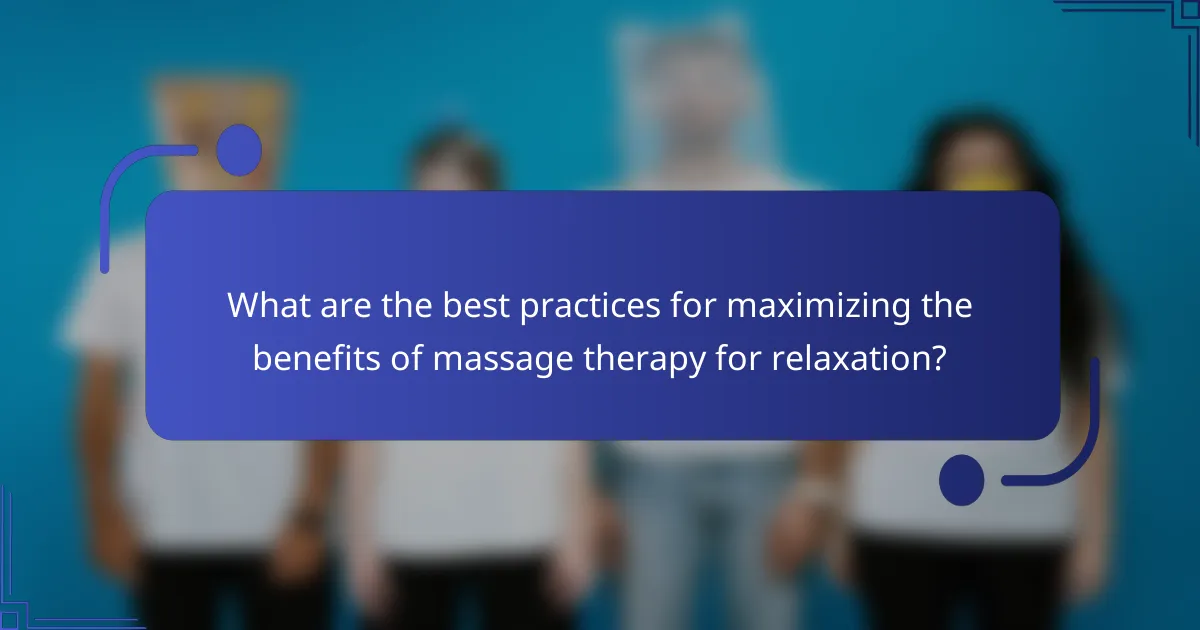
What are the best practices for maximizing the benefits of massage therapy for relaxation?
To maximize the benefits of massage therapy for relaxation, focus on consistent sessions, skilled therapists, and a tranquil environment. Regular appointments enhance muscle memory and stress relief. Choosing a certified therapist ensures proper techniques are applied, while a calming atmosphere promotes deeper relaxation. Incorporating aromatherapy or soothing music can further enhance the experience.
How should clients prepare for a relaxation massage session?
Clients should arrive well-hydrated and in comfortable clothing for a relaxation massage. They should communicate any specific areas of tension or discomfort to the therapist. Arriving a few minutes early allows time to relax and fill out any necessary paperwork. It’s beneficial to avoid heavy meals or alcohol before the session to enhance relaxation.
What aftercare tips can enhance the effects of massage therapy?
To enhance the effects of massage therapy, focus on hydration, gentle stretching, and rest. These practices support muscle recovery and overall relaxation.
1. Drink plenty of water to flush out toxins.
2. Perform light stretching to maintain flexibility.
3. Rest adequately to allow your body to recover.
4. Apply heat or cold packs as needed for soreness.
5. Avoid strenuous activities immediately after the session.
Which common mistakes should clients avoid when seeking relaxation through massage therapy?
Clients should avoid over-communicating discomfort and neglecting personal preferences when seeking relaxation through massage therapy. Clear communication is essential, but excessive feedback can disrupt the flow of the session. Additionally, clients should prioritize their comfort by discussing specific areas of tension or preferred techniques upfront.
Another mistake is arriving stressed or rushed, which can hinder relaxation. Taking time to unwind before a session enhances the overall experience. Clients may also overlook the importance of setting realistic expectations regarding the immediate effects of massage therapy. Understanding that relaxation can vary from session to session helps manage outcomes.
Lastly, neglecting aftercare recommendations can diminish the benefits of the massage. Staying hydrated and allowing time for rest are crucial for maximizing relaxation.

